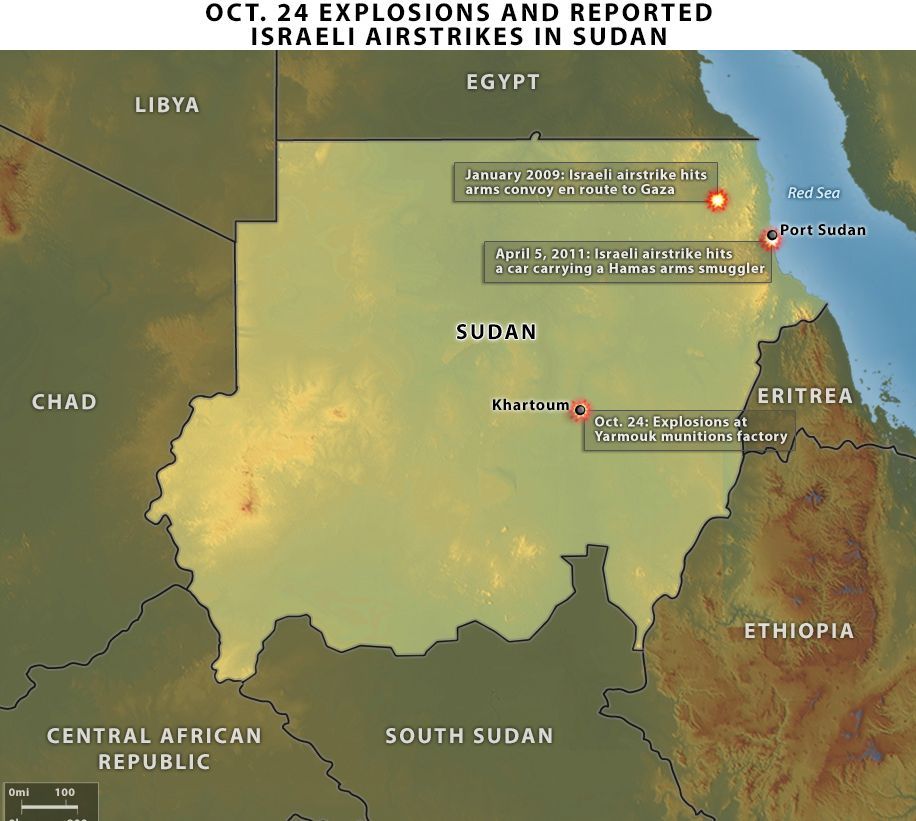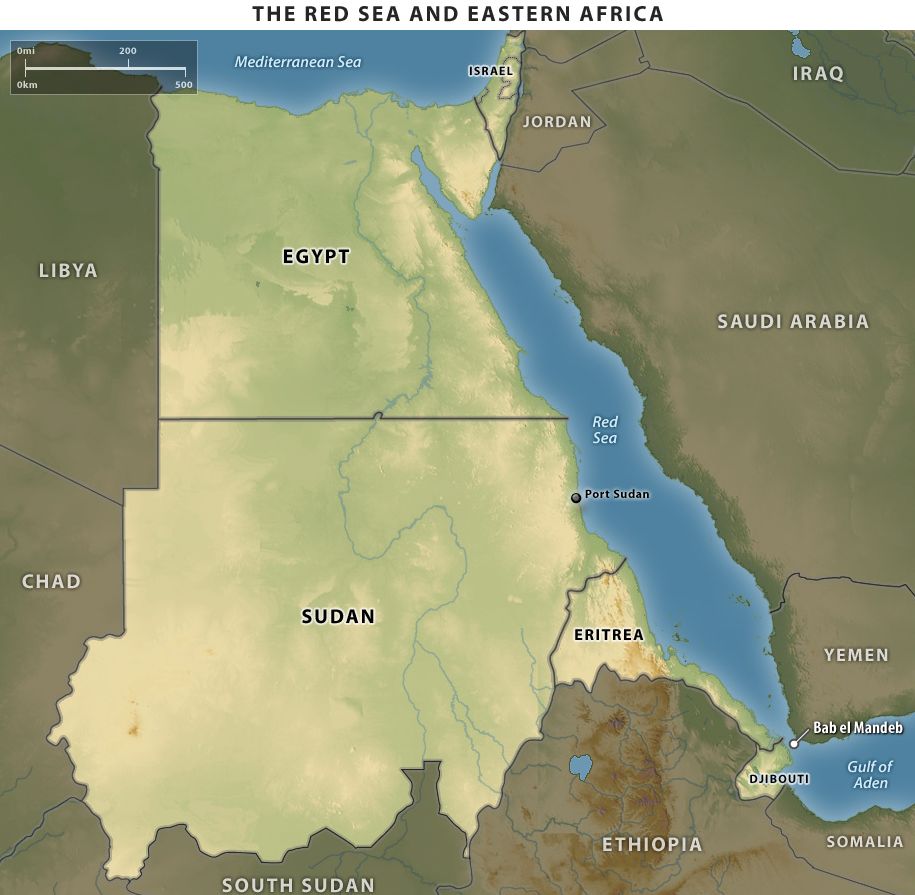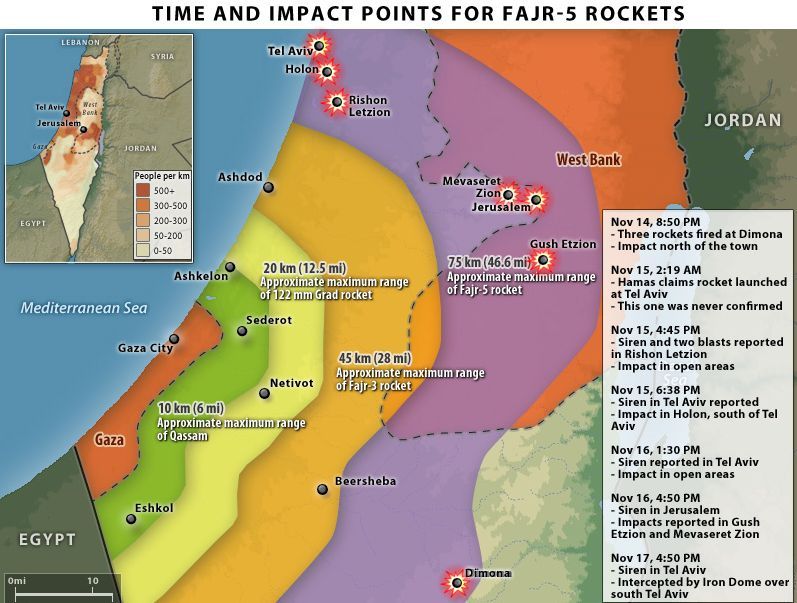Yesterday we presented a graphic indicator as to the range of the rockets and a map with its targets.
However none of the mainstream media outlets have reported about the
Iranian connection in the case of the Gaza Offensive.
The Fajr-5 rockets that Hamas and
Palestinian Islamic Jihad have been launching toward Tel Aviv and Jerusalem
were initially manufactured by Iran and smuggled from Sudan through the Sinai
Peninsula. That is why on 24 Oct. Israel
attacked the Iranian weapons facility in Khartoum because Iran was using
this facility to stockpile and assemble the long-range Fajr-5 rockets now
capable of reaching Tel Aviv and Jerusalem from Gaza.
The incident highlights Iran's maneuvers and Israel's concerns in
eastern Africa. Tehran has sought to establish land routes for weapons
trafficking from the Indian Ocean and Red Sea into Gaza and Israel in order to
support militants in the region -- particularly Iranian proxy militant groups
on Israel's borders and in the Levant. This, along with the importance of the
maritime route through the Red Sea and Gulf of Aden to the sustainability of
these land routes, has made Sudan and the Red Sea part of a secondary
battleground between Iran and Israel.
More important it is shortly after the above mentioned Israeli
raid that the present barrage of missiles from Gaza gradually started.
On Nov. 14, Jabari
was assassinated, and Hamas had to work under the assumption that Israel would
do whatever it took to launch a comprehensive military campaign to eliminate
the Fajr threat. It is at this point that Hamas
likely resigned to a "use it or lose it" strategy and launched Fajr rockets toward Tel Aviv, knowing that they would be
targeted anyway and potentially using the threat as leverage in an eventual
attempt at another truce with Israel.
We are usually skeptical about information coming trough
Debka (hence it is the first time I use it here)
however we have been able to have the cited information positively double
checked.

Iran has used not only the Sudanese coastline but also Eritrea and
possibly Djibouti or Somalia to smuggle arms onto land before shipping them to
their destination. Eastern Africa’s porous borders make smuggling along land
routes relatively easy.

Given their large size, the Fajr-5s are typically smuggled one at a time
and in separate parts. Following the example of Hezbollah's preparations in the
Second Lebanon War in 2006, Hamas relies on an extensive underground tunnel
system to assemble the rockets. Recent weekly newsletter Iran trained several
Palestinian technicians on how to assemble the Fajr-5s, and there are likely a
few of the Islamic Revolutionary Guard Corps' Quds Force operatives in Gaza for
this purpose. The Palestinians likely gave the assembled rockets the M-75 name
to support the claim that they were locally manufactured.
Yet it now appears that forces in Gaza may be manufacturing long-range
rockets locally. If this is the case, a significant ground force offers the
Israelis the best chance of finding and neutralizing the factories making these
weapons (although information
coming through the last few minutes indicates the ground force might be delayed).
Meanwhile, Israel continues its airstrikes on Gaza, and Gaza continues its
long-range rocket attacks on major Israeli population centers, though Israel
claims its Iron Dome defense system has intercepted most of the rockets.
Why this will complicate the
situation
If Palestinian militants can manufacture long-range rockets in Gaza, it
will be much more difficult for Israel to restrict Gaza's inventory of these
rockets. Beyond rocket launch sites and caches, which Israel is currently
targeting with its airstrikes, it would need to target production sites and
those who would be responsible for manufacturing the rockets.
Furthermore, it will be significantly harder for Israeli intelligence to
form an accurate picture of the number of these rockets locally constructed in
Gaza.
Learning from Hezbollah's example in 2006, special units of Hamas are
relying heavily on tunnels to maintain communications. Should Israel be drawn
into more densely populated areas of Gaza in pursuit of weapons storage and
manufacturing facilities, Hamas has also reportedly prepared its suicide
bombers, to raise the cost for Israel in an urban battle.


For updates click homepage
here